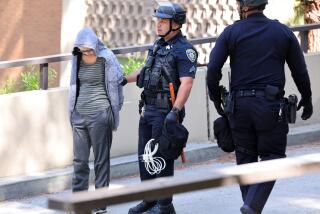ACLU Asks Judge to Enforce His Jail Orders
In a move that could result in early releases for many inmates, the American Civil Liberties Union asked a federal judge Friday to require that Los Angeles County limit jail overcrowding.
County officials said they expect the judge to grant the request, because he is merely being asked to enforce orders that he issued previously in a longstanding ACLU lawsuit.
Sheriff Sherman Block said that about 1,000 convicted misdemeanants will probably have to be released up to three days ahead of schedule.
The federal intervention, if it occurs, is also expected to result in pressure on state courts to assign more judges to criminal matters--possibly on staggered shifts.
Warnings of Chaos
Both the ACLU and the district attorney’s office said that such federal intervention could have a chaotic impact on state courts in Los Angeles.
That would stem indirectly from one of the orders that John Hagar, the ACLU’s attorney, is asking U.S. District Judge William P. Gray to enforce. It requires that the Sheriff’s Department provide a seat to every inmate in a holding cell waiting to be bused to court.
“They’re in those cells for hours . . . packed in like cattle,” Hagar explained.
But providing seats for inmates awaiting buses means that the Sheriff’s Department will have to bus inmates to court in shifts, and some inmates will not reach court until noon, Hagar said.
“This is going to cause massive problems,” Hagar predicted.
Contentions Disputed
However, Frank S. Zolin, the county clerk and executive officer for the Superior Court in Los Angeles, disagreed, saying, “If Judge Gray signs the orders as anticipated, we will be ready. . . . We don’t see where that’s going to be a terrible disruption.”
Zolin said he believes that jailed defendants whose trials are under way will reach court by 9 a.m. “Now,” he said, “we call calendars at 9 a.m. and begin jury trials at 10 or 10:30. We will have to reverse the process and call calendars later.”
The ACLU’s decision to ask Gray to enforce his orders came a week after the Los Angeles Superior Court decided to limit, as inefficient, a pilot program aimed at easing overcrowding by assigning more judges to criminal cases.
The program, begun at the urging of the ACLU and in place for 90 days, resulted in a small reduction in jail population, saving about 100 beds in an eight-jail system with 22,500 inmates, about 10,000 more than it was designed to accommodate, county officials said. Under the program, felony defendants awaiting trial were processed more rapidly by the additional criminal court judges.
Zolin said he regards the ACLU’s move for federal intervention as “leveling the gun at us, if you don’t mind that phrase.”
“I feel we’re getting very polite blackmail with this,” he said.
Hagar said, however, that increasing courtrooms devoted to criminal matters is the only sensible method to address overcrowding in Los Angeles County’s jails, which he noted has more inmates than the prison systems of all but four states.
‘Immense Success’
Hagar’s request that Gray enforce orders in a 13-year-old lawsuit against county officials won by the ACLU in 1979 is supported by the district attorney’s office, which viewed the pilot program as “an immense success.”
Chief Deputy Dist. Atty. Gilbert Garcetti said, “In light of the Superior Court’s reluctance to go forward with the . . . (full) program . . . we can appreciate the need . . . for the ACLU to seek relief in the federal court.”
Crowding is particularly acute at the downtown Men’s Central Jail, which Hagar said is “the largest penal facility in the Free World.” The population there hovers around 8,200--about 1,400 more than Gray’s orders allow.
If Gray signs the ACLU’s request next week, Block said he will transfer the 1,400 to other county jails that already are overcrowded. That may trigger the release of inmates who are within three days of completing their sentences.
“If that doesn’t give us the numbers we need, the next step would be (releasing) those not yet adjudicated but who are in because they are not able to post bail up to a maximum of $2,000, which would mean they are minor offenders,” the sheriff said.
Sentences Reduced
As a practical matter, an inmate sentenced to 30 days in the county jail now spends 15 days there, the sheriff said.
The inmate gets one-third off his sentence--in this example, 10 days--for good behavior and for holding down a job in jail. In addition, inmates for years have routinely been released an additional five days early to ease overcrowding, the sheriff said.
With up to an additional three days off, a 30-day sentence could turn into 12 days of actual jail time.
Garcetti said he expects a compromise to head this off.
“My guess is there’ll probably be the order signed (by Gray) and maybe sometime between the signing of the order and its implementation, an agreement will be reached by all parties,” he said.
More to Read
Start your day right
Sign up for Essential California for news, features and recommendations from the L.A. Times and beyond in your inbox six days a week.
You may occasionally receive promotional content from the Los Angeles Times.





